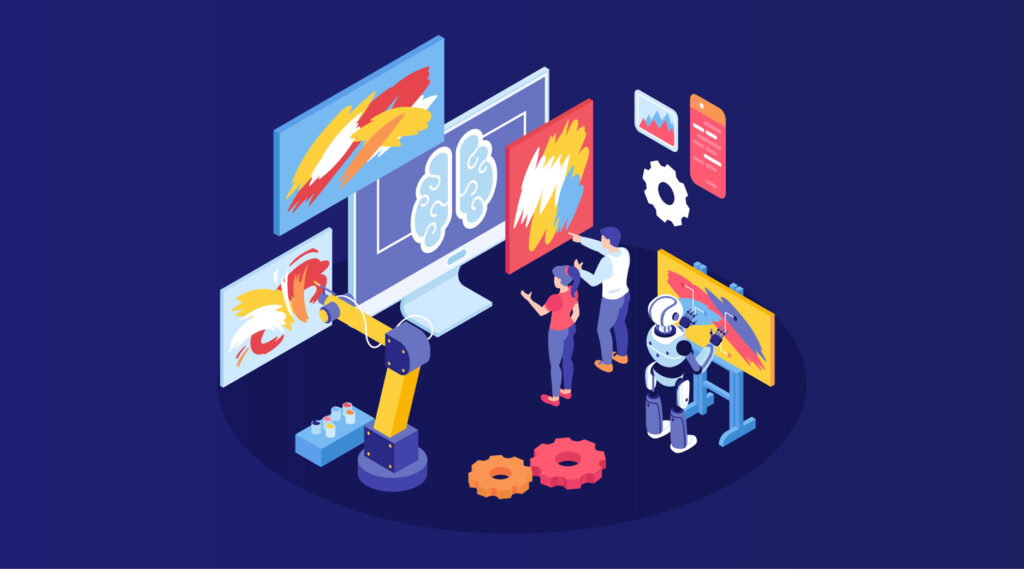Table of Content
The AI Landscape Today
The AI landscape is evolving rapidly, with enterprises moving beyond experimentation and into full-scale AI adoption. As AI models become more powerful and accessible, businesses are faced with critical decisions about how to deploy AI effectively, which tools to invest in, and how to integrate AI into existing workflows.
Three major trends are shaping AI adoption:
- AI is shifting from model-centric to data-centric architectures. Instead of relying solely on fine-tuned models, businesses are increasingly using retrieval-augmented generation (RAG) and real-time data access to enhance AI accuracy and adaptability.
- Multi-model strategies are replacing single-model dependency. Enterprises now use a mix of proprietary, open-source, and domain-specific models to balance performance, cost, and customization.
- AI deployment is becoming a competitive differentiator. Companies that invest in AI infrastructure, observability, and security can create more reliable and scalable AI-driven solutions, giving them an edge in automation and decision-making.
Understanding this evolving AI landscape requires a structured framework for assessing AI infrastructure, deployment options, and operational challenges. The following sections break down the AI tech stack, providing a roadmap to navigate AI adoption, optimize investments, and build scalable AI applications.
The AI Tech Stack: Breaking Down the Key Layers
Different frameworks present the AI tech stack in various ways, depending on their focus. Some models, like a16z’s three-layer stack [1], emphasize Applications, Models, and Infrastructure, while others incorporate Data, Deployment, and Observability to address enterprise scalability.
Understanding the AI tech stack is crucial for businesses looking to make informed AI investment decisions. Most companies are not competing to build foundation models but instead focus on leveraging AI tools, integrating AI into workflows, and developing industry-specific applications. The real competitive advantage lies in how well AI is integrated into business operations, rather than just developing AI models in isolation.
The AI stack helps organizations decide where to position themselves—whether at the application layer, in model development, or by investing in AI infrastructure. Instead of building their own models, businesses can also create value by optimizing AI adoption through tailored applications and data-driven solutions.
In this section, we break down The AI Tech Stack into its key layers, synthesizing insights from multiple frameworks to provide a practical guide for business leaders navigating AI integration.
AI Infrastructure and Model Layer
The compute layer is the foundation of AI operations, providing the infrastructure needed for both training and inference. This includes high-performance chips, cloud-based computing platforms, and pre-trained foundation models, which power AI applications across industries.
To handle large-scale AI workloads, companies rely on cloud providers, while specialized hardware such as GPUs, accelerators, and TPUs delivers the computational power required for deep learning. The choice between cloud-based AI services and on-premise deployments depends on factors such as scalability, cost efficiency, and security requirements.
As businesses refine their AI strategies, they are increasingly adopting multimodal AI approaches, using a mix of proprietary and open-source models to balance performance, cost, and customization. While cloud AI solutions provide rapid scalability, they also come with rising operational costs. In contrast, on-premise and edge AI deployments are gaining traction in industries with strict data privacy requirements, offering greater control over sensitive AI workflows and reducing long-term reliance on external providers.
Choosing the right mix of compute infrastructure and foundation models is critical to optimizing performance and cost-effectiveness.
Advancements in AI models are driving the commoditization of foundational AI capabilities, making AI more accessible, flexible, and cost-efficient. Open-weight models such as LLaMA and DeepSeek are reducing reliance on proprietary APIs, allowing businesses to deploy AI on-premise, fine-tune models for industry-specific needs, and lower operational costs.
At the same time, improvements in model efficiency are reducing hardware dependencies, enabling the AI to scale across enterprise applications, embedded AI features, and real-time automation. As AI becomes more cost-effective and accessible, adoption is accelerating across industries, allowing businesses to integrate AI-driven solutions at scale without requiring extensive infrastructure investments.
Data Layer
The effectiveness of AI models depends on the quality, accessibility, and structure of the data they process. The data layer plays a crucial role in ensuring that AI systems retrieve, process, and structure information efficiently, enabling real-time knowledge retrieval and decision-making. Rather than relying solely on static, pre-trained knowledge, modern AI architectures dynamically access external and enterprise-specific data sources, improving accuracy and adaptability. This requires robust data management strategies, including ETL pipelines that ingest, clean, and structure raw data before it is fed into AI systems.
To enhance AI performance and minimize hallucinations, organizations must modernize their data infrastructure, integrating vector databases and metadata stores to optimize AI-driven retrieval. Vector databases [2] are a core component that allows AI models to store and retrieve embeddings, enabling fast, context-aware searches for relevant information.
Metadata stores help organize and manage structured and unstructured data, ensuring efficient indexing and retrieval for AI-driven decision-making. Instead of fine-tuning models with extensive training runs, which can be costly and time-intensive, businesses are increasingly leveraging retrieval-augmented generation (RAG). This approach enables AI to pull relevant information from external knowledge bases in real time, improving response accuracy without the need for continuous retraining.
Deployment Layer (AI Model Orchestration & Operations)
The deployment layer ensures that AI models are efficiently integrated into business applications, optimized for performance, and orchestrated across various workflows. It governs how AI models interact with users, data, and enterprise systems, ensuring scalability and efficiency at every stage.
AI orchestration tools like LangChain, LlamaIndex, and Fireworks help businesses route AI queries to the most suitable model, optimizing both performance and cost. These tools not only manage query distribution but also refine and optimize prompts, ensuring AI-generated responses align with business objectives.
As AI deployment evolves, businesses are adopting architectures that enable models to retrieve relevant data in real-time, rather than relying solely on static fine-tuned knowledge—a shift driven by in-context learning. This approach enhances AI adaptability, accuracy, and responsiveness, reducing the need for costly retraining cycles.
Effective prompt management further improves model accuracy, minimizes unnecessary API calls, and optimizes multi-step workflows. Agent frameworks extend this capability by enabling AI-powered automation, allowing models to execute complex reasoning tasks and interact dynamically with enterprise workflows.
To simplify AI implementation, low-code deployment platforms provide ready-to-use AI tools, reducing the need for extensive in-house AI expertise. As AI workloads scale, enterprises are increasingly adopting multi-model routing strategies, where different AI models handle different tasks, balancing efficiency and cost.
Many organizations are also shifting toward serverless AI computing, leveraging cloud-based infrastructure that automatically scales AI resources based on demand. This reduces operational overhead, allowing businesses to focus on AI-driven innovation rather than managing infrastructure complexities.
Application Layer
The Application Layer represents the front-facing AI-powered products and services that businesses deploy to end-users. Unlike the infrastructure and deployment layers, which focus on optimizing AI performance and model orchestration, this layer focuses on how AI is integrated into real-world applications—whether through internal enterprise tools, customer-facing software, or fully AI-native platforms.
AI applications fall into two main categories: Standalone AI Applications and Embedded AI Features. Standalone AI applications are end-to-end AI-powered products, where AI is deeply integrated into core functionality, such as AI copilots for software development, automated legal document analysis, and AI-driven content creation platforms. In contrast, embedded AI features enhance existing applications by integrating AI-powered capabilities, as seen in enterprise SaaS platforms.
Alongside product-focused AI applications, AI services are emerging as a major expansion area. Businesses are outsourcing AI capabilities [4] to specialized AI service providers, which offer AI-powered automation, customer support solutions, enterprise AI copilots, and vertical-specific AI models. These AI-first service providers enable companies to rapidly integrate AI without needing to develop or manage models internally. This shift is reshaping enterprise AI adoption, making AI applications more accessible while creating new service-based revenue models.
Newer reasoning models, such as o3-mini and DeepSeek [3], optimize performance across different effort levels, making AI applications more cost-efficient and adaptable to enterprise use.
As AI adoption accelerates, businesses face challenges in the Application Layer, particularly in retention and differentiation, as many AI applications rely on the same foundation models, making it difficult to stand out.
Monetization strategies remain a critical factor, with companies deciding between pay-per-use models, enterprise licensing, or embedding AI as a value-added feature. Additionally, model and cost dependencies create strategic concerns—AI applications that rely on external APIs must balance performance with cost efficiency, while those developing proprietary models face high infrastructure and training expenses.
Observability & Security (Ensuring AI Reliability)
As AI becomes a core component of business operations, ensuring its reliability, security, and compliance is essential. AI systems must be continuously monitored to detect performance degradation, bias, and unintended behaviors that could impact decision-making.
AI observability tools help track model performance, identifying issues such as model drift and hallucinations before they affect business outcomes. These tools provide insights into how AI models generate responses, enabling organizations to refine their AI strategies and improve transparency.
To effectively manage the operational complexity of AI deployments, businesses are increasingly adopting LLMOps (Large Language Model Operations) frameworks. These solutions provide model validation, prompt evaluation, and error tracking, allowing enterprises to monitor model outputs, detect inconsistencies, and fine-tune AI performance in real time.
Prompt evaluation frameworks help teams assess AI-generated responses for accuracy, coherence, and unintended biases, ensuring models remain aligned with business objectives and regulatory requirements.
LLM security and compliance are equally critical, as AI applications handle vast amounts of sensitive data. Platforms designed for AI security and governance help protect against cyber threats, unauthorized access, and potential data leaks, ensuring that AI deployments remain robust and trustworthy. Enterprises operating in regulated industries must also ensure that their AI systems comply with privacy laws and industry regulations such as GDPR and HIPAA.
Additionally, mitigating bias in AI models is a growing priority, requiring investments in fairness and accountability tools to uphold ethical AI standards. As businesses scale AI adoption, maintaining continuous monitoring, robust security measures, and LLMOps-driven observability will be essential to ensuring long-term AI reliability and public trust.
Where Should Businesses Invest in AI?
Understanding the AI tech stack allows business leaders to make informed investment decisions and strategically allocate resources. For companies prioritizing cost control, investing in open-source AI models and multi-model routing can significantly reduce reliance on expensive proprietary models while maintaining flexibility.
Organizations with strict security and compliance requirements should focus on on-prem AI deployment and observability tools to ensure data privacy, regulatory adherence, and system integrity. Meanwhile, businesses seeking to differentiate themselves through AI should invest in proprietary AI workflows and vertical AI applications, allowing them to develop domain-specific solutions with competitive advantages.
By aligning AI strategy with overall business goals, leaders can maximize ROI while avoiding costly missteps in an increasingly complex and fast-moving AI landscape. This includes not only choosing the right layer of the AI stack but also investing in developing AI skills. Without skilled AI engineers, data scientists, and MLOps professionals, even the best technologies won’t deliver results.
Market Trends and Competitive Landscape
The enterprise AI landscape is undergoing a massive shift from experimentation to execution. Businesses are no longer just testing generative AI—they are now embedding it into core operations at scale. In 2024, enterprise AI spending surged, reflecting a strategic shift from exploratory pilots to full-scale AI deployment.
Organizations are integrating AI into software development, customer support, enterprise search, data extraction, and automation, transforming these functions through AI-powered copilots, AI chatbots, and intelligent knowledge retrieval systems.
As AI adoption accelerates, businesses are optimizing their infrastructure, shifting towards multi-model AI strategies, and integrating with proprietary data sources to improve the accuracy and relevance. Hybrid deployments are becoming the preferred model, blending cloud-based AI with on-premise customization, particularly in industries requiring data sovereignty and security compliance.
The AI market is shifting from a model-centric to a data-centric approach, where retrieval-augmented generation (RAG), multi-model routing, and AI observability are emerging practices. The companies that will lead in AI will be those that invest in scalable infrastructure, secure AI workflows, and tailored AI-driven applications—rather than relying on off-the-shelf solutions with limited flexibility.
References:
[1] Who Owns the Generative AI Platform?
[2] Emerging Architectures for LLM Applications
[3] The Batch AI Newsletter, February 5, 2025
[4] Tech services and generative AI: Plotting the necessary reinvention













Omg i’m so hyped about this blog post!!! it’s giving me a major insight into the gen ai landscape and tech stack. i’ve been working with LLMs for a while now, and it’s crazy to see how fast they’re evolving. one thing that stood out to me was the emphasis on customising the AI tech stack to suit different use cases – totally agree! generative ai is all about scalability, and ai development services need to be adaptable too.
Refs [1] & [2] are def worth checking out for more info
I completely agree that the choice of AI tech stack plays a crucial role in optimizing performance and cost-effectiveness. However, I would like to see more discussion on the importance of model interpretability and explainability in multimodal AI approaches.
Well written! You nailed it on ai tech stack investments for businesses!
I’ve witnessed firsthand how enterprises are embracing AI transformation. In my current role as a systems analyst, we successfully integrated an enterprise AI platform into our existing infrastructure, resulting in significant process automation and improved decision-making capabilities. It’s been a game-changer for us! The shift to data-centric architectures has allowed us to stay agile and adapt to changing business needs.
I thoroughly appreciated the insightful analysis on the generative AI landscape and tech stack. I was particularly intrigued by the mention of newer reasoning models like o3-mini and DeepSeek optimizing performance for enterprise AI use cases. Could you elaborate on how these advancements address the challenges in the Application Layer, specifically regarding retention and differentiation?
I completely agree that advancements like o3-mini and DeepSeek address challenges in Application Layer retention and differentiation. By optimizing performance, these newer reasoning models enable AI companies to develop more adaptable and efficient applications, ultimately improving their competitiveness.
Whoa, I’m stoked you found that analysis insightful! As for those newer reasoning models like o3-mini and DeepSeek, they’re game-changers for enterprise AI by optimizing performance across different effort levels. They make AI applications more cost-efficient and adaptable for use in the enterprise setting. It’s a total win-win, folks! The challenges in the Application Layer are being addressed by these advancements, making it easier to stand out with retention and differentiation.
I think the o3-mini and DeepSeek advancements help address retention and differentiation by making AI applications more adaptable and cost-efficient, but I’d like to see a more in-depth analysis on how these improvements translate to machine learning consulting and real-world business outcomes.
Hey author, can you elaborate on enterprise AI use cases?
I must say, I appreciate the effort to break down the Generative AI Landscape and Tech Stack into digestible categories. However, as someone who’s worked with AI companies for years, I’d like to add that this tiered approach oversimplifies the complexities of integrating AI into real-world applications. For instance, the distinction between Standalone AI Applications and Embedded AI Features often blurs in practice. I’ve seen many cases where organizations opt for a hybrid approach, leveraging both internal model development and external services from specialized providers. This nuanced perspective is essential when exploring the evolving role of AI-first service providers in enterprise adoption.